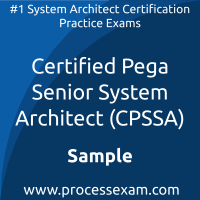01. Which two steps do you perform to use node classification?
(Choose Two)
a) Classify application servers by cluster according to their purpose.
b) Associate system requestors with appropriate node types.
c) Configure background processing to occur at specific times during the day.
d) Configure application servers with node types according to their purpose.
02. A developer has identified resource-intensive queue processors as the source of performance issues that application users are experiencing. Which two actions do you perform to resolve the performance issues?
(Choose Two)
a) Associate the queue processors with the appropriate node types.
b) Configure the queue processors to run multiple times a day.
c) Configure the application nodes with node types.
d) Select the Include in background processing option on the application rule.
03. In which scenario is a Declare OnChange rule appropriate?
a) When a manager approves a case, the case is routed back to the appropriate caseworker.
b) When a developer changes a view, the change is checked into a development branch.
c) When a user updates their address, the active case is suspended until the address can be confirmed.
d) During a nightly backup process, only updated fields are backed up.
04. Which two configurations are required when adding a Split for Each shape to your case life cycle?
(Choose Two)
a) Enter a rule that stores the audit note that you want to include in the subprocess.
b) Enable users to get back to the subprocess after the case moves forward.
c) Enter the Page List or Page Group property that is the basis of the split.
d) Define when the parent process resumes processing.
05. An application includes three case types. A business requirements states that members of the App:Users access role cannot run reports for one of the case types. Which configuration can you apply to satisfy this requirement?
a) Use an Access When record to verify that the user role has access to the Run reports action.
b) Use an Access When record to verify that the case type has access to the Run reports action.
c) Use an automation to verify that the user does not have the App:Users access role.
d) Use an Access Deny record to set the Run reports action to No Access.
06. Your application has a top-level Purchase Request Case Type and a Purchaser Order child Case Type. The company determines that only one user at a time may open and work on a Case. However, users working on purchase orders should not lock out users working on purchase requests.
How do you configure the lock settings for both Case Types?
a) Select the Allow one user locking option on the Purchase Request Case Type and select the Allow access for the parent Case when the child Case is opened option on the Purchase Order Case Type.
b) Select the Allow one user locking option on the Purchase Order Case Type and the Allow access for the parent Case when the child Case is opened option on the Purchase Order Case Type.
c) Select the Allow multiple users locking option on the Purchase Request Case Type and select the Allow access for the parent Case when the child Case is opened option on the Purchase Order Case Type.
d) Select the Allow one user locking option on the Purchase Order Case Type and the Allow access for the parent Case when the child Case is opened option on the Purchase Request Case Type.
07. When the workflow in your Case is _____, you can use _____ to run one or more _____ in the same Stage _____ to allow users to perform Tasks independently to complete the work in the Stage.
a) complex, post-processing, subprocesses, simultaneously
b) complex, parallel processing, subprocesses, simultaneously
c) complex, pre-processing, spinoffs, simultaneously
d) complex, typical processing, subprocesses, simultaneously
08. When designing reports with multiple data sources, in which two ways is an association rule different from a class join?
(Choose Two)
a) You can join multiple classes with class joins, while you cannot join multiple classes with associations.
b) Anyone with the appropriate permissions can use associations when creating reports in the User portal.
c) Class joins are unique to each report. Associations are reusable in any report.
d) A class join is required to add a filter condition to your report.
09. In which of the following two situations do you use circumstancing?
(Choose Two)
a) The sales tax rate changes at the first of next year.
b) Attach PDF file of expense list to approval request when total amount is more than USD1,000.
c) Employee PTO accrual rate varies by number of years in service.
d) A new manager is assigned to the team from the first of next month until the end of the quarter.
10. Which requirement is supported by attribute-based access control (ABAC)?
a) Bakers with a rating of 4 or better can add recipes to the database.
b) Managers can reschedule but not delete appointments.
c) Personal identifying information in the Work-Baking- class is restricted.
d) Customers have view access to all attachments on a case.
 You have to pass the CPSSA exam to receive the certification from Pega. To increase the effectiveness of your study and make you familiar with the actual exam pattern, we have prepared this Pega Senior System Architect sample questions. Our Sample Certified Pega Senior System Architect Practice Exam will give you more insight about both the type and the difficulty level of the questions on the PEGACPSSA24V1 exam.
You have to pass the CPSSA exam to receive the certification from Pega. To increase the effectiveness of your study and make you familiar with the actual exam pattern, we have prepared this Pega Senior System Architect sample questions. Our Sample Certified Pega Senior System Architect Practice Exam will give you more insight about both the type and the difficulty level of the questions on the PEGACPSSA24V1 exam.